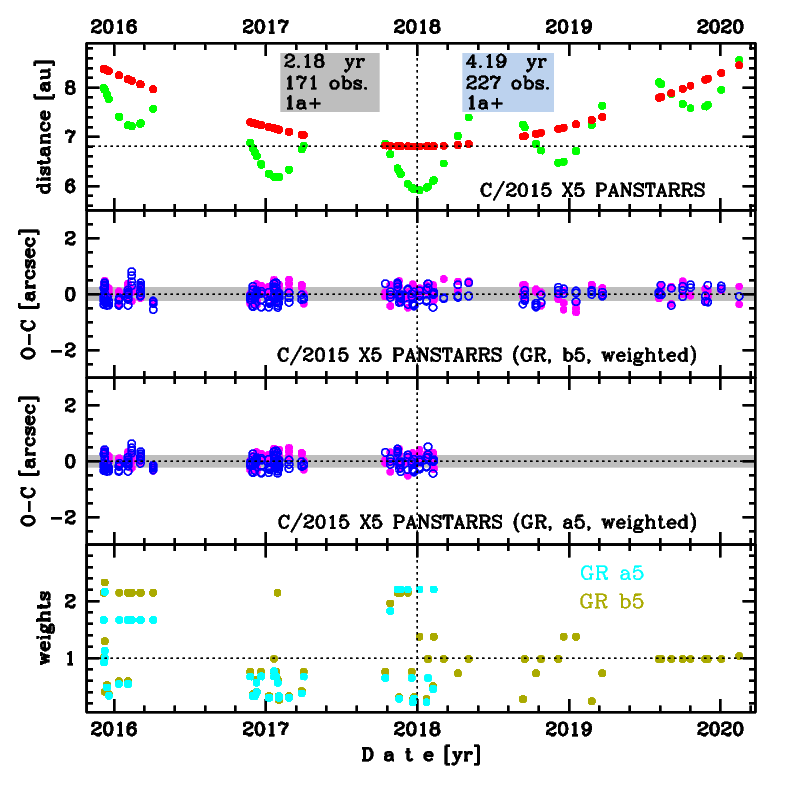C/2015 X5 PANSTARRS
more info
Comet C/2015 X5 was discovered on 6 December 2015 with Pan-STARRS 1 telescope (Haleakala), that is almost 2 years before its perihelion passage.
Comet had its closest approach to the Earth on 4 January 2018 (5.909 au); 4 days after its perihelion passage.
The preferred solution given here is based on data spanning over 4.19 yr in a range of heliocentric distances: 8.38 au – 6.80 au (perihelion) – 8.45 au.
This Oort spike comet suffers tiny planetary perturbations.
Comet had its closest approach to the Earth on 4 January 2018 (5.909 au); 4 days after its perihelion passage.
The preferred solution given here is based on data spanning over 4.19 yr in a range of heliocentric distances: 8.38 au – 6.80 au (perihelion) – 8.45 au.
This Oort spike comet suffers tiny planetary perturbations.
| solution description | ||
|---|---|---|
| number of observations | 227 | |
| data interval | 2015 12 06 – 2020 02 14 | |
| data type | perihelion within the observation arc (FULL) | |
| data arc selection | entire data set (STD) | |
| range of heliocentric distances | 8.38 au – 6.80 au (perihelion) – 8.45 au | |
| detectability of NG effects in the comet's motion | NG effects not determinable | |
| type of model of motion | GR - gravitational orbit | |
| data weighting | YES | |
| number of residuals | 439 | |
| RMS [arcseconds] | 0.24 | |
| orbit quality class | 1a+ | |
| orbital elements (heliocentric ecliptic J2000) | ||
|---|---|---|
| Epoch | 2018 01 02 | |
| perihelion date | 2017 12 31.02821393 | ± 0.00040685 |
| perihelion distance [au] | 6.80173288 | ± 0.00000286 |
| eccentricity | 1.00332107 | ± 0.00000318 |
| argument of perihelion [°] | 27.752267 | ± 0.000028 |
| ascending node [°] | 122.314518 | ± 0.000005 |
| inclination [°] | 124.290911 | ± 0.000008 |
| reciprocal semi-major axis [10-6 au-1] | -488.27 | ± 0.47 |

Upper panel: Time distribution of positional observations with corresponding heliocentric (red curve) and geocentric (green curve) distance at which they were taken. The horizontal dotted line shows the perihelion distance for a given comet whereas vertical dotted line — the moment of perihelion passage.
Middle panel(s): O-C diagram for a given solution (sometimes in comparison to another solution available in CODE), where residuals in right ascension are shown using magenta dots and in declination by blue open circles.
Lowest panel: Relative weights for a given data set(s).
Middle panel(s): O-C diagram for a given solution (sometimes in comparison to another solution available in CODE), where residuals in right ascension are shown using magenta dots and in declination by blue open circles.
Lowest panel: Relative weights for a given data set(s).